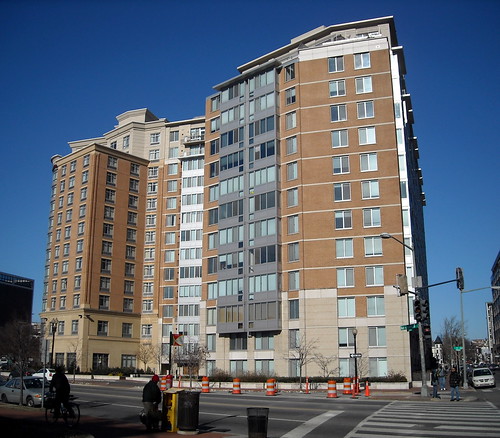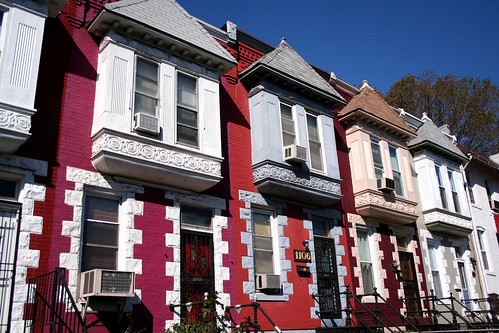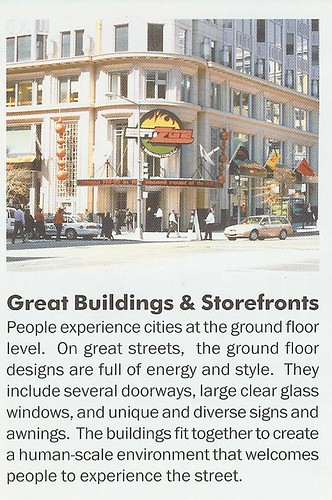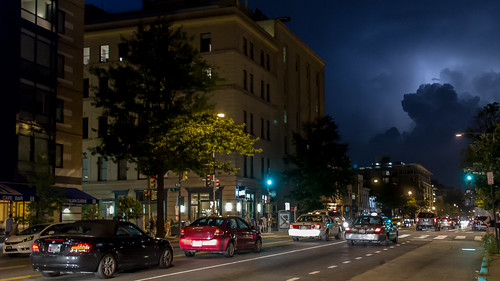Millennials, hipness, "rowhouse-y charm," and authenticity
I don't write about it so much anymore (e.g., "(Not) Understanding that DC's competitive advantage rests in part on non-automobile transportation infrastructure"), but I ascribe to the city five competitive advantages which collectively support the city as a place to live, to work, and to visit.
1. historic residential building stock (that is attractive to people with decent incomes who have choices on where they decide to live)
2. an urban design (at least in the core of the city) that favors compact development, mixed use (locating amenities and civic uses close by), walking, and transit
3. history, identity and authenticity
4. a rich transit infrastructure that allows for efficient mobility without having to be automobile-dependent
5. the steady employment engine of the federal government.
I didn't mean in the previous post to sound denigrating.
I just don't see millennials moving to the city being much different from the various other people who moved into the city from the 1960s forward, people who were attracted to urban rather than suburban communities, because of the lifestyle and amenities packages.
The difference is that the attitudinal change is reaching critical mass--although this doesn't mean that everyone wants to live in the city-- and we can't necessarily ascribe this to tv shows like "Friends" and "Seinfeld"--shows set in a city (New York City) and weren't too critical of the city as a city. Note that while Seinfeld used the city partly as a set, in Friends the city was mostly invisible outside of the apartments that the characters lived in.
Maybe we should add "Sex and the City" to this list as well. The show's narrative thrust didn't appeal to me but it showed living in the city to be the thing to do, and many of the shows featured city scenes.
 Rowhouse-y Feel.
Rowhouse-y Feel.Left: 555 and 559 Massachusetts Avenue NW. Flickr photo by Josh/NCinDC. The building on the right is a condo and the leftmost building is a hotel.
One of the articles in the Post Magazine package discussed the Chinatown-Gallery Place neighborhood, where most of the residential options are new multiunit buildings. From the article:
Chinatown doesn't have everything but it has enough of the right thing to attract millennials by the bunch: central location and multiple enormous, relatively new apartment buildings... The two qualities millennials say the neighborhood lacks -- decent night life and that rowhouse-y charm or 'real' DC -- are just a cab or Metro ride away.
 Right: rowhouse buildings on 8th Street NE, one block from Gallaudet University. Flickr photo by Elise Bernard.
Right: rowhouse buildings on 8th Street NE, one block from Gallaudet University. Flickr photo by Elise Bernard.The point about "rowhouse-y charm" comprising "real DC" is very important, especially because in other new urban writing settings, historic preservation and historic preservationists are usually derided.
I am saddened by the derision because I make the point often that it was the historic preservation movement that stabilized DC, especially the neighborhoods in the core of the city, during the many decades that residential choice trends did not favor urban living.
Millennials are attracted to the city because of its historic buildings and walkable urban design which dates to the Walking City Era (1800-1890) of urban development.
 Attractive traditional commercial districts are attractive because of their historic building stock
Attractive traditional commercial districts are attractive because of their historic building stockWhile the article only mentions it in passing, the nightlife destinations that people are attracted to are also comprised mostly of historic building stock used commercially. Places like Georgetown, H Street, Adams Morgan, 14th Street NW, U Street, 8th Street SE/Capitol Hill.
Many years ago the Downtown DC Business Improvement District produced a brochure that outlined the Principles of Quality Storefronts and Principles of Great Streets. It's long out of print but I scanned a goodly part of it.
New buildings in those places do best when they design and build out their first floor spaces according to the same precepts used from the 1880s to 1930s--high ceilings, large storefront windows, small store widths, frequent entry points, etc.
Cities can't get distracted and must focus on their competitive advantages
For all the talk of arts-related development and the creative class, in many ways it's merely what I think of as "applied Jane Jacobs."
 Right: 14th Street NW at night. Flickr photo by Clif Burns.
Right: 14th Street NW at night. Flickr photo by Clif Burns.While she wrote two books specifically about the urban economy (The Economy of Cities and Cities and the Wealth of Nations) the kernel of her economic writings are in the section of Death and Life of Great American Cities when she writes about the need for a large stock of old buildings to support innovation--not necessarily because they were old and we are fortunate that the late 1800s and early 1900s were great times for the creation of architecturally attractive buildings (even if it took us many decades to appreciate it)--but because they were paid off and cheaper to rent (although not when demand is super high and the inventory is fixed).
Living in multiunit buildings enables people to live in the city, but design-wise, maybe it isn't as definitional as the historic residential and commercial building stock dating (primarily) from 1930 and before.
How the hell do we get everyone on the same urban design and placemaking page?
That's the big question.
And I will attempt to answer it later in the week.
Labels: commercial district revitalization, demographics, neighborhood revitalization, nightlife economy, urban design/placemaking, urban revitalization



11 Comments:
I'm sure it is unintentional that the former ESPNzone hsas been vacant for how many years?
You (and others) have tirelessly pointed out that DC is captureing more vs. the region, so the new college grad that used to live in a garden apartment in Arlington is now in Mt. Vernon.
And to me, that is the biggest difference in the past 5 years. I noticed it at bars in Arlington -- the girls were getting older. Younger girls were in DC bars.
And diversity of building stock. If you've got an era like Mt Vernon it is going to start to all go down at the same time.
(but the real estate market is always about new construction, not used houses/condos).
The brochure is from before 2002. I don't know the exact date. (And it would take me a year to be able to find my copy, easy.)
2. Yes, good point about decline setting in at the same time because of the housing being constructed at the same time.
That's why Toronto has a "tower renewal" program, dealing with issues in buildings that are now 40 years old or more. A big reason that they can do it though is energy retrofitting, which is revenue positive.
I have commented that one of the unintended consequences of creating mixed use districts of owner occupied housing is that when a building's facade gets tired, it will be damn hard to get a group of condo owners to agree to an assessment just for that, because it's unlikely it will come back in increased property value...
wrt the age demographics, there is a decided difference too between Bethesda and DC nightlife districts. Good point.
Mike -- it's really tough to look at those demographics, because there is no question that the suburbs, which still comprise the bulk of a land area in a metropolitan area, are going to continue to attract more residents than cities on a gross numbers basis.
The real issue to me is that it isn't all one way outbound now. That cities, at least some of them, are staunching some of their losses.
That is a big deal, even if Joel Kotkin continues to denigrate the city. But just on a numbers basis, the cities aren't going to be able to outdraw the suburbs. It's not possible.
And yes, you're absolutely right about DC going through the great re-sort. African Americans continue to move out of the city. Without younger people and whites and Hispanics moving in, the city would otherwise be shrinking, still.
This makes the "gentrification" "discussion" very difficult, because it isn't a fine-grained discussion.
http://urbanplacesandspaces.blogspot.com/2012/05/too-early-to-say-what-special-election.html
http://urbanplacesandspaces.blogspot.com/2013/07/what-is-inclusive-city.html
http://urbanplacesandspaces.blogspot.com/2011/03/gentrification-neighborhood-change-and.html
I get the appeal of rowhouse neighborhoods, but the implicit assumption here is that apartment living doesn't count as urban somehow - which is wildly false and misleading.
Single family attached homes (e.g. rowhouses) account for about 25% of the city's housing stock. Buildings of 20+ units account for ~35%.
The problem with "rowhouse-y charm" and preservation is that when preservation denies the city the room to grow, that causes problems. And you can maintain the charm without relying solely on row houses to provide your housing. Much of what many would consider 'rowhouse-y charm' could also be described as 'walk-up apartment charm.' Infill development should be the friend of preservation, and too often it is not.
Tough to sell a walk up with more that 3 flights. And then you get into elevators, which start becoming a major expense item in condo budgets.
Bizarrely, I suspect package thefts will start to drive people away as well -- only going to be more important and more of a problem in certain types of housing.
Presumably if you have a brownfield development you could put a block of row houses in it. Less money for the developer, but I suspect the density might be enough to support urban charms. Even more so if you make a few of those multi-units.
Alex B. -- I think multiunit buildings are fine. But it's clear that at least in the core neighborhoods, the Post got the sentiment that "millennials" defined real neighborhoods in terms of rowhouses.
Now, frankly, I think that is more a function of their upbringing, likely in single family housing, it just happened to be in the suburbs.
Outside the core, you have a significant multiunit tradition in what in NYC they call pre-War buildings (by which they mean WWII) and we have many buildings like that up 16th St., Wisconsin, Connecticut, Massachusetts, etc.
In 2001, I met a young couple working here temporarily, from Brazil. He was a lawyer. They asked my advice about living here. Some people were steering them to Van Ness. I suggested that they might want to consider Clarendon... I can't remember where they ended up.
Alex B. -- also, there is no question that multiunits will have more units (using the air), the issue isn't percentage, so much as area occupied by the housing type. More DC land and neighborhoods are dominated by the rowhouse.
2. No arguments from me on the value and importance of infill. And my cred as a preservationist. Others aren't so similarly inclined. That's a problem, obviously, as I have written about ad infinitum. The problem is that preservationists haven't figured out how to deal with a growing city, when they came to the fore when stabilization was the most important goal in the face of population shrinkage.
3. I have lamented the fact that we didn't do plexes or NYC style walkups, although charlie is absolutely right that it sucks to walk up 3-6 flights of stairs, as we've all done at least once, visiting someone in Manhattan.
charlie -- yes, UPS leaves packages on the porches in our neighborhood. Occasionally people have problems.
I have not understood why UPS doesn't (1) shift their home delivery schedule in cities to the evening hours and (2) doesn't create a couple of in-city depots to leave packages for pickup.
I think this is something that should be covered in a transportation plan.
http://urbanplacesandspaces.blogspot.com/2013/07/city-transportation-departments-need-to.html
Again, I wouldn't read that too literally.
Key distinction: defining "rowhouse-y" as a neighborhood that has rowhouses vs. living in only rowhouses.
Example: Dupont Circle has lots of rowhouses, but I would guess that the majority of the people live in the apartment buildings interspersed between them.
And I think the relevant metric in terms of this WaPo article is how the people live, not how much of the city is occupied by row houses. You can live in a rowhouse neighborhood without living in a rowhouse - I do. (And I do take 4 flights of stairs most of the time - only use the elevator with groceries, etc).
I have to disagree, at least slightly.
Where they live has two dimensions; the place and the dwelling unit. The place--in this case a neighborhood--is really important. It appears that they choose to define desirability of neighborhood in terms of historic architecture and yes rowhouses. Although location is fundamental and maybe even more fundamental.
It's not like they are choosing to live on Rockville Pike even though there is a Harris-Teeter they can drive to. Grosvenor is full of apartment buildings...
Post a Comment
<< Home